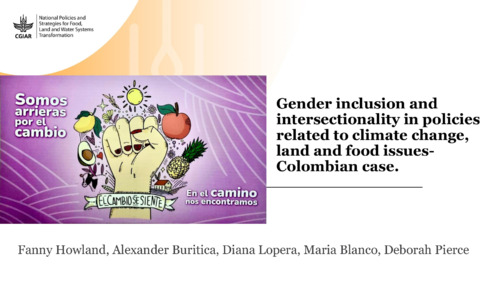Gender inclusion and intersectionality in policies related to climate change, land and food issues - Colombian case
Although progress has been made in promoting gender equality in governments; gender and intersectional inequalities in national agrifood and climate policies are rarely meaningfully considered neither systematically addressed (Acosta et al.; 2019, 2020). The nexus between climate, agrifood and gender issues is relevant. Climate and gender policies often follow a top-down approach without integrating women’s and men’s knowledge, vulnerabilities and demands (Howland and Le Coq, 2022) and do not address structural causes of gender and intersectional inequalities (Huyer et al., 2020). The link between gender and food issues is related to power and control in food systems and related to a set of social, economic, and physical conditions (Patel, 2012). We propose an innovative methodology to assess gender and intersectionality integration in policies based on the concepts of policy integration, policy translation, and policy coherence. Intersectional gender lens is crucial, as gender-blind policies often prioritize the needs of men and dominant social groups, neglecting the needs of women and marginalized populations (Criado-Perez 2019). Through policy documents analysis and informant interviews, we examine how gender and intersectionality are portrayed and integrated in climate and agrifood policies, using as case study Colombia. Results show that, despite having made multiple international commitments on gender issues and having gender-labeled policy and governmental gender bodies, gender mainstreaming in the policy cycle is lagging, and intersectionality considerations are limited. There are multiple barriers of a different nature and at different levels that explain this situation, such as the policy translation from the international level; structural policy barriers at the national level; behavior and corruption; and the lack of knowledge and capacity.
At the policy translation level, although gender is integrated in sectorial and national policy, this does not necessarily translate into bridging or closing gender gaps. At the structural policy level, there is a gap between the creation of policies and their implementation. The lack of gender integration in implementation comes from the way governments operate; divided by sectors and not accustomed to working on cross-cutting issues. Furthermore, the weakness of the gender institutional framework in terms of human resources staff capacity constitutes an additional barrier.
This leads to the coexistence of different definitions of gender equality and gender inclusion in policies and, consequently, different conceptions of how to achieve it. Intersectionality is poorly considered in policies and limited to general categories such as ‘rural women’ in agriculture policy or limited to a specific function of women within food issue (rural women not as beneficiaries but as potential nutrient provider for malnourished children through breastfeeding) in food policies. The technical approach taken in regard to Climate Change often results in a lack of attention to the social aspects of climate change and thus a lack of gender and intersectionality inclusion.

